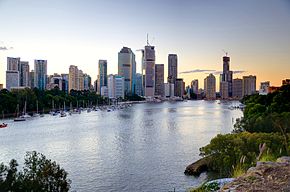About Brisbane
|
Brisbane is the capital of the state of Queensland. It has a population of about 2 million people, making it the third-largest city in Australia. Located in Queensland’s south east corner, Brisbane has something for everyone. Known as Australia’s new world city, Brisbane leads the nation in innovation and discovery yet embraces a down-to-earth attitude that welcomes visitors with open arms. The city is alive with attractions and things to see and do. Flanked on two sides by one of Australia’s busiest working rivers – The Brisbane River, the city is shaded and cooled by tropical vegetation which cover the town like a green umbrella. The pace is informal, the atmosphere welcoming and friendly. Warm summer breezes from the Pacific Ocean sweep across the city and wash the air with the scent of the sea. |
|
Dotted with museums of all styles, galleries covering a diverse range of art and a food-lover’s booty of fabulous restaurants, clubs and bars, the city can be a very tempting place. There is just so much fun to have during the day and late into night. Brisbane’s arts precinct is located in South Bank, just a short bus or ferry ride from the University of Queensland St Lucia campus - home to the Queensland Art Gallery, Queensland Performing Arts Centre, Queensland Museum, Opera Queensland, Queensland Theatre Company and State Library.
South Bank also houses Streets Beach, a unique artificial swimming beach overlooking the Brisbane River and the city’s CBD. Sub-tropical trees and exotic plants surround the beach, which is patrolled seven days a week by experienced, professional lifeguards. The lagoon contains enough water to fill five Olympic swimming pools and the 4000 cubic metres of sand surrounding the beach is topped up every year with an additional 70 tonnes of sand sourced from Moreton Bay to ensure it is kept in its pristine condition.
Further Information About Brisbane
For more information about Brisbane, visit www.brisbanemarketing.com.au
Climate
Brisbane could easily be described in one word – warm. Australia’s northernmost state capital, it’s warm by virtue of its sub-tropical location and warm because of its people. Brisbane's wet season runs from October to March. January is typically humid, with high temperatures (maximum daytime temperatures rise to 31-33°C) and thunderstorms in the afternoon. So remember to pack plenty of shorts and short-sleeved shirts since the summer heat and high humidity will make you sweat! Remember to pack sunscreen and a wide brimmed hat as Queensland has high rates of skin cancer and it is very easy to get sunburnt.

About Australia
Australia is one of the most colourful countries in the world in so many ways. From the sub-tropical north, to the temperate south, the entire country is bathed in a warm sunshine that brings out its natural blues, reds and greens. It’s like holidaying in the brushstrokes of an impressionist’s painting.
Australia is a big country, similar in size to mainland USA and much bigger than all the countries of Western Europe. And it’s big on attractions too.
A trip to Australia isn’t complete without experiencing its iconic and beautiful sites. There’s good reason why Queensland’s Great Barrier Reef is considered one of the natural wonders of the modern world – it’s just so beautiful. The northern tropical warmth brings out the surfer, diver, and swimmer to the blue, blue water – every day of the year.
Australia is a land of contrasts – it’s beautiful yet rugged, sophisticated yet relaxed, stylish yet unpretentious, diverse yet united.
We look forward to welcoming you to our country for the Australian Student Conservation Conference in 2013.
